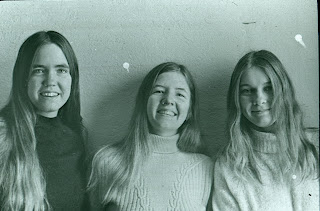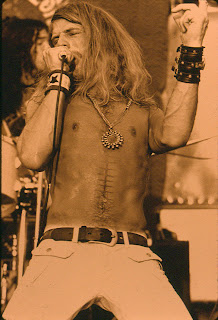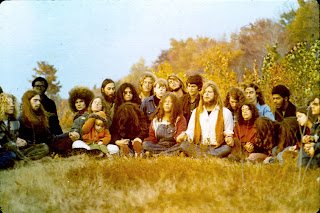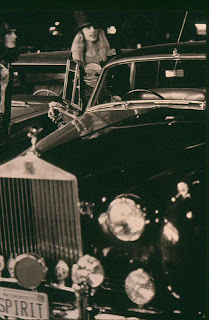 FASHION
FASHION In Which Pure Materialism Is Not Yet Hypocritical
 Tuesday, February 10, 2009 at 11:15AM
Tuesday, February 10, 2009 at 11:15AM 
In or Out?
by Anna Dever-Scanlon
on cults and fashion
I had this idea to write a piece on cults and fashion. I started browsing the internet and found a lot of pictures of various cults, some scary, others not. The Manson Family came up often, as did Heaven's Gate, the Branch Davidians, and Jim Jones' People's Temple. Actually, those are all pretty scary.

The Manson Family: just not normal
I did some more research, reading a psychiatrist's account of his experiences treating a patient who'd left a cult called the Frontiersmen in the early eighties. What became clear is that no matter what kind of cult it is - religious or not, right leaning or left leaning, ending in murder, explosions, or mass suicide or just quietly dispersing, the key element behind every cult is the sheer force of personality of a charismatic leader.
In a cult, clothing is just one of many tools used by the leader to manipulate his followers and assert his dominance. Whatever the rules, they are usually completely arbitrary, although in the mind of the leader they are tied to their chosen religious or philosophical beliefs. In the photo shown above, the Manson women followed Charles Manson's lead when, during their murder trial, they cut their hair shorter and shorter until one day they shaved it all off. This seemingly arbitrary act, explicable only if you had access to the inner workings of Manson's mysterious mind, had the effect of further promulgating his terrifying persona.
At the Yearning for Zion Ranch cult that was part of a widely-publicized child abuse scandal last year, the women wore long, anachronistic prairie dresses that looked like they came straight out of the 1850s. I'm not sure what the rational was for this, although I am guessing it was related to leader/polygamist Warren Jeffs' belief that women should be pregnant all the time, like in the olden daze. The rules themselves don't matter so much as the fact that there are rules, and that they reinforce the agenda of the cult leader.

Girls at the Yearning for Zion Ranch
Aside from these well-known groups that fit into the traditional view of cults as extremely negative and harmful, there were many cults in the sixties and seventies that were much more positive experiences for the majority of participants. One of the most striking fashion-wise was the Source Family, founded by Father Yod (born James Edward Baker) in Los Angeles. Father Yod oversaw a successful restaurant and psychedelic rock band in the early seventies and seems to have been pretty benign, espousing mostly vegetarianism, meditation and occasional herb smoking. Father Yod started his teachings in the Kundalini yoga tradition and at first, most participants wore all white, as was customary for Kundalini practitioners.

Members of the Source Family
As time went on the clothing style evolved, but Father Yod continued to wear long Jesus robes that added to his mystique. Yod's followers also wore long cotton or velvet robes that evoked ancient Greece and Egypt or Medieval England. Their look was an integral part of their appeal and many prospective members were overcome by the visual as well as spiritual draw of the community. In the book, The Source: The Untold Story of Father Yod, YaHoWah13 and the Source Family, one former member, Yahava, recalls her first encounter with the family. "I saw a group of angels standing in golden sun rays singing with all their might. Their bodies appeared completely translucent in the night, as if they were all in golden white clothes and had golden white long hair: men, women, and children. I could not make this apparition real. I thought I was really tripping."

Father Yod
The sixties saw a proliferation of these groups that often walked the line between cult and commune. The Love Family, a Seattle based outfit run by Love Israel (born Paul Erdman) was one, as was the Renaissance Community in Western Massachusetts - of which my parents were members.

The Love Family

The Renaissance Community
No one was coerced to stay in these communes, but I think the influence of the leaders was remarkable at times. The Renaissance Community went through many phases, and during one of the more cult-y periods the leader, Michael Rapunzel (born Michael Metelica), bought a bunch of sweaters in different colors - white, maroon and brown. Those he considered part of his inner circle were told to wear the white sweaters (since they were spiritually pure), those who were only at a medium level of spiritual enlightenment were told to wear maroon, and those who were deemed unenlightened were instructed to wear brown. Despite whatever inner bullshit-o-meters may have been going off, most people went along with this, my parents included, a fact I find mind-bogglingly hard to fathom. The obvious irony here is that spirituality, which is supposed to be about transcending the material world, was being dictated through clothing, something so clearly superficial.

Renaissance Commune women in sweaters
In The Source, Isis Aquarian (born Charlene Peters) talks about the stylistic differences between the Love Family and the Source Family. "Love's family was earthy: they tilled the land and grew their own food and lived simply, Love's women were dressed plainly and demurely. We, on the other hand, had a house in Hollywood and served organic cuisine to rock stars; our women wore custom-designed jewelry and ran around the house with low cut gowns with our breasts bursting out." The sensual nature of Source Family dress spoke to their custom of polyamory or "sex magic" as they called it. I showed my Dad the Source Family book and he said, "Oh yeah, I remember this guy coming to visit - the Father. They were totally into group sex." He flipped through the pages, stopping at a picture of Father Yod holding a scepter and remarked, "This is just charlatanism." Members of the Source Family recall outings with Father Yod where they felt he was parading them around to get attention. One tells of a time when they went out to eat at an expensive restaurant and were seated next to Ronald and Nancy Reagan, much to Fathers delight. I think Father Yod may have taken things over the top at times, but I also think he was sincere in his spiritual beliefs and, as one former member put it, "he was the best show in town."

Michael performing with Spirit in Flesh
Members of the Renaissance Community wore pretty standard hippie styles - headbands, bellbottoms, ponchos, flowing skirts. They were more like the Love Family, being in a rural area and engaged in carpentry, gardening and other non-glamorous activities. However, Michael certainly had a flair, and when performing with his band Spirit in Flesh, tended to have a more rock and roll look, with a little biker sensibility mixed in for good measure.

Members of the Renaissance Community meditating in standard garb
In a commune where material goods are supposedly shared equally, clothing and other adornments can cause deep conflict. At one point Ahom (born Robin), Father Yod's original wife and one of the managers of the Source Restaurant (the business which supported the entire family), was accused of spending too much money on clothing and jewelry for herself. As a result, Father Yod made everyone pool everything they had and sell it, keeping one piece of jewelry each. At the Renaissance Community, there was a period when Michael had a Rolls Royce and an airplane and mothers would have to ask him for money to buy shoes for their kids. Clearly, confusion can ensue when religion and money get together.

Michael getting in the Rolls
Looking at behavior around clothing in the context of these groups brings into relief the patterns people demonstrate in mainstream society. Outside of cults, it seems like people are ever eager to impose rules on themselves. Kids join cliques that are largely based on dress - goth, punk, skater, preppie, etc. As adults, people spend fortunes to impress their co-workers with office attire - to look competent, prosperous, and promotable. The fashion obsessed look for themes running through designer's collections that can be construed as the season's "rules" to follow. Clothing signifies group identification as well as hierarchies within those groups.

Gladiator sandals: Do or don't?
It is as though people feel more comfortable, in fact, with structure than with total freedom. The same desire for belonging that drives individuals to join cults pushes them to mold themselves into the season's latest trends or the attire of whatever group they want to be a part of. Even those who believe they are outright rejecting fashion are expressing something very specific, their desire to be seen as not influenced by fashion's whims and to be accepted by people who share their disdain.

David Koresh

Anna Wintour
"Fashion cults" - groups that define themselves purely according to dress are a manifestation of the powerful draw of clothing. In this type of situation, clothing is the primary focus of a social group, not simply a secondary concern after religion or work. Japanese teenagers who dress in the Gothic Lolita style are good examples of this. Here, the emphasis is on fantasy and dress-up, and group acceptance is based on how well you dress the part. In this instance, clothing is not a means to the end of social control, it is the end itself, a form of entertainment like sports. Unlike spiritual cults, there is no higher meaning attached to the style of dress, it is valued in itself, not for its signification of something deeper. One could say that this is pure materialism, but at least it's not hypocritical.

Japanese Gothic Lolitas
I often wonder what it was about the late 60's and early seventies that made people so susceptible to membership in cults. Some would say it was the spiritual energy of the Aquarian Age. I suspect it was a searching quality on the part of the young, a yearning to re-define the rules of society. Inextricable from this desire to remake the world is an arrogance, a belief that you can actually accomplish this sort of re-formulation. Ironically, in trying to create a better world, rules that would have seemed repellent in the context of normal society suddenly became acceptable.
Yet, I wonder if the type of rules that are set up in cults are really much different from the rules of dress in society as a whole. The only difference I can see is that in a cult they are explicit, whereas in the mainstream they are inferred. Their main similarity is their arbitrariness. Just as cult leaders create random strictures to force their members into obedience, the fashion industry lays down edicts each season for people to follow, lest they be deemed unfashionable. It is this arbitrariness that lends the rules their power, making them all the more unpredictable and mysterious. Fashion, in its non-verbal, non-analytical way can instill more slavishness than other expressions of loyalty precisely because of this random, inexplicable quality that implies that those who are making the rules understand something that those who are following them can't grasp.

Geek glasses: inexplicable
In his book, Beloved Son: A Story of the Jesus Cults, Steve Allen writes about his experience visiting his son Logic Israel, a member of the Love Family, during a trip to the Source Family (the two groups had become friendly at this point). Remarking on the dizzying combinations of Eastern and Western religious thought in one of Father Yod's sermons - blending everything from Judaism to Christianity to Astrology to Tarot to Buddhism and everything in between, Allen wonders, "How does one differentiate between various aspects of the non-rational?" All cults and communes depend on a certain suspension of rational thought to exist, as do all religions. Thereign lies their allure, as well as their danger.
In the same way, fashion and personal style have nothing to do with rational thought, or we would all be wearing uniforms with air vents and pocket protectors. As with religion, in fashion there is always a temptation to go overboard, to lose the ability to think rationally before buying a $20,000 Birkin bag or platform heels that are impossible to wear. Is Anna Wintour David Koresh with a bob? Certainly not, but if something seems ridiculous, it probably is.
Anna Dever-Scanlon is a contributor to This Recording. She lives in Brooklyn. Her blog is here.

"Junk Queen" - Catherine Feeny (mp3)
"Santa Ana Wind" - Catherine Feeny (mp3)
"The Mighty Whale & Abraham" - Catherine Feeny (mp3)

PREVIOUSLY ON THIS RECORDING
Cheney tackles Lost really hard.
Magic Molly visits hep clubs.
What to enjoy about New York.






























Reader Comments (8)
I thought this article was going to be about Slanket/Snuggie wearers
great piece
An interesting and insightful piece, much appreciated. Arbitrary overlays and want of structure indeed.
I apologize if my original comment sounded flip. This quality of this post and blog in general make me crazy. Excellent post.
This is not a non sequitur
this is not a non sequitur
(don't watch after the 2 minute mark if you believe this to be a non sequitur)
http://staugustinian.wordpress.com/2009/02/15/andy-patty/
[...] In Which Pure Materialism Is Not Yet Hypocritical [...]
That’s the best fact. Is this practicable to order the realtones ringtones or get ringtones from this site?
Your note supposes to be smashing, but there are a big quantity arguments to order the online term paper from the write my essay service. This can present people an advantage to have high level!